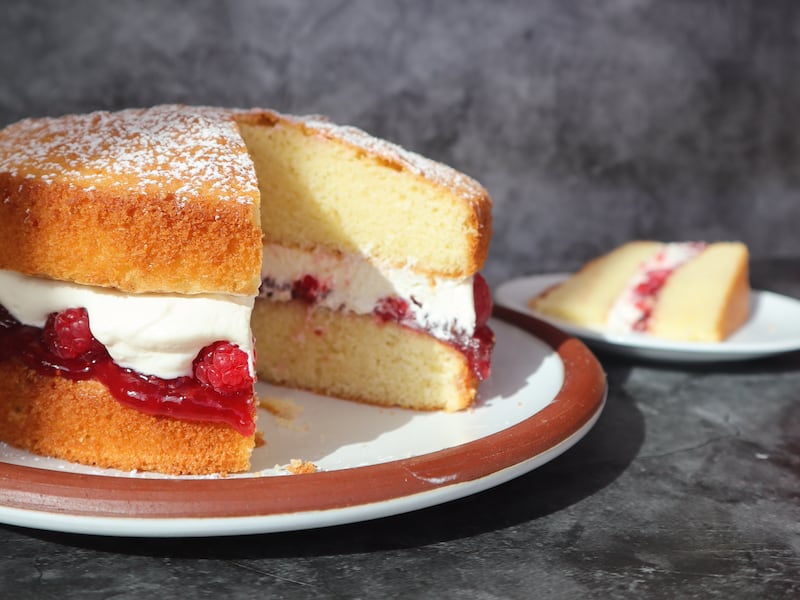Queen Victoria loved afternoon tea, so much so that this classic sponge cake was named in her honour. Her reign coincided with the mid-19th century invention of baking powder, a chemical leavening agent used primarily for cakes and biscuits which revolutionised home-baking. Many variations on the theme exist, but it is likely that the queen herself would have enjoyed something similar to the recipe below, with jam and whipped cream.
I tested six Victoria sponge cakes, using recipes created by some of the baking titans of the past 50 years (Delia Smith, Darina Allen, Mary Berry and Jane Grigson), along with two more contemporary versions by Nigella Lawson and Jamie Oliver.
The sponge
There are two main approaches that can be adopted for the sponge. The most popular is a “pound cake” style, usually with butter, sugar, eggs and flour in equal quantities (1lb of each, hence “pound”) plus raising agent (either baking powder, or with self-raising flour substituted for plain). Alternatively, you can make a whisked sponge (in the Genoese style), which Jane Grigson does, with great results. The whisked sponge is much lighter and keeps better, but lacks the flavour of the butter-based sponge.
Mixing method
If making a pound cake type sponge, some recipes (Delia Smith, Mary Berry and Nigella Lawson) use the all-in-one method, which simply involves beating all ingredients together in a food processor or stand mixer until combined. While this is the fastest method, I prefer the slightly more time-consuming approach, where soft butter and sugar are creamed until light and fluffy, and then eggs and dry ingredients are added in alternating increments.
READ MORE
Leavening
The whisked sponge is leavened mainly by incorporating air into the eggs, whisking at a high-speed for some time. Pound-style cakes rely on a chemical leavener, and I prefer to use baking powder over self-raising flour as you have full control over the amount you use. Don’t be tempted to add extra baking powder – rather than producing a lighter, fluffier cake as you might expect, the sponge might rise too quickly and consequently collapse in the centre.
Flavouring
The flavour of the sponge comes mainly from the butter and eggs, so use good quality ingredients. Use high-fat Irish butter if you can, and if it’s not salted, add a pinch of salt. You can also add some vanilla, or citrus zest which complements the fruit filling nicely. If you’re making this as a celebration cake and it will be covered with buttercream and perhaps enjoyed a day or two after baking, you can also brush the baked sponge with a flavoured syrup, which will improve the flavour and texture of the cake, and improve its shelf life.
Tins
I prefer to use sandwich tins for this, as I find the cakes bake more evenly in a shallower tin. You can also bake in one seven-inch tin and slice it through the middle before filling, but it will take longer to bake, so make sure you test it’s baked through before removing from the oven. To line the tins, it’s safest to line the bottom and sides with baking parchment, using a pastry brush and neutral oil to stick the paper to the tin. Another method taught to me by JR Ryall at Ballymaloe is to only line the bottom of the tin, and then while the cake is still hot (about three minutes after it comes out of the oven), loosen it from the edges of the tin with a sharp knife. Done properly, this can leave you with really straight, clean edges.
Filling
Any combination of jam, fruit, cream and buttercream can be used, but my personal favourite combination is jam, fresh berries and cream whipped to the perfect consistency – too soft and it will not hold its shape, but too stiff and the texture will be uneven and unpleasant. Buttercream is also used in some recipes (including Mary Berry’s), and it makes for a neater slicing experience, but in my opinion, the texture of freshly whipped cream is superior for this particular style of cake.
Recipe: Beth O’Brien’s classic raspberry Victoria sponge

Sources:













